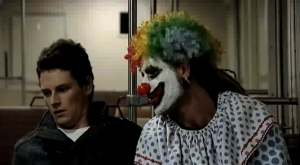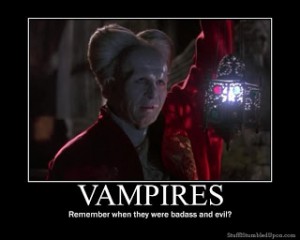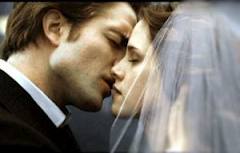Clown Train – Sound Design
The sound design used in the film Clown Train creates an eerie, somewhat disturbing feeling whilst developing anticipation over the sequence of shots. The use of diegetic sounds such as a train drawing to an end as well as sounds associated to mechanical failure draw attention to the characters’ presence inside the train. The camera work also contributes to reiterating the space of the train by filming from the outside of the train and looking in on the characters. The sound is also altered to appear as though you are looking into the train when the camera is outside of the train. Additionally, an electric zapping sound is used to build anticipation as well as division between shots – where the clown repositions himself closer to the other character when the zapping sound occurs and the train lights falter. The zapping sound forms a motif throughout the shot sequence and the viewer expects for the clown to move in on the other character whenever the sound strikes.
Image taken from http://www.youtube.com/watch?v=6dX9bfCbJdw
The Ring also enhances sounds within its filmic space to build anticipation and an element of fear. A scene comes to mind where a character is in his warehouse apartment and nothing particularly out of the ordinary is happening – however the soundscape draws attention to his presence within the apartment and creates anticipation within the scene through enhancing focal and field sounds.
Below is an excerpt from The Ring from a notably ‘chilling’ scene that has been edited to have no sound. I find that watching the excerpt without sound looses the sequence’s intensity and it becomes evident how important sound is in creating anticipation and an awareness of fear.
This also relates back to what Alten suggests in his paper, ‘Creating the Sound Design’ when he tells that sound in film can have the ability to “Affect aural perception” (6).
Rolling, Student Film – Analysis
The student film, Rolling seemed to work well within the limitations of the constrained task. The film used a simple yet effective plot with appropriate casting that carried the film’s narrative. The film had a good selection of locations that was feasible for the production of the project. Another aspect that I found worked well was that the dialog was minimal and many things were conveyed through acting or camera work. Having watched the short film a few weeks ago now, my memory isn’t too sharp on the specifics; however, I remember thinking some of the camera angles weren’t consistent e.g. the space above the character’s heads differed. All in all, I think the short film was entertaining, well rounded and that the students worked well within the set perimeters.
Creating the Sound – Reading Reflection
Creating the sound design. In Alten, S. Audio in media, (p.266-286). Belmont: Wadsworth, 1994.
Alten’s article titled, ‘Creating the Sound Design’, informs how sound can assist in conveying the narrative by preloading what is to come (7). In the article, Alten speaks of how countless aspects of sound recording can have implications on the narrative. Additionally, Alten speaks of how the sound producer may design the sound in various mediums to convey a number of feelings. Alten also highlights the extensive detail and consideration sound designer emplace to convey meaning.


